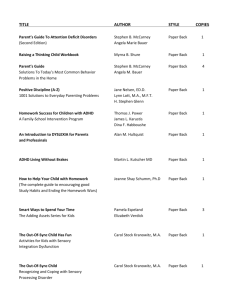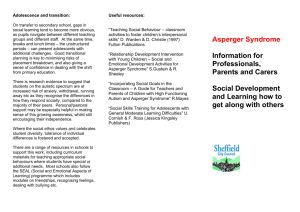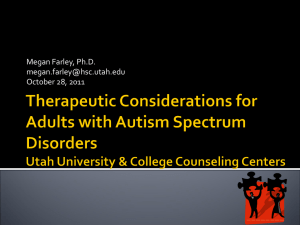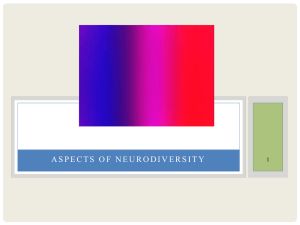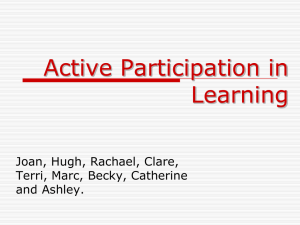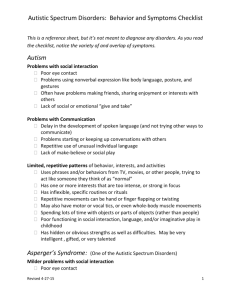INTRODUCTION TO ASPERGER`S & AUTISM
advertisement
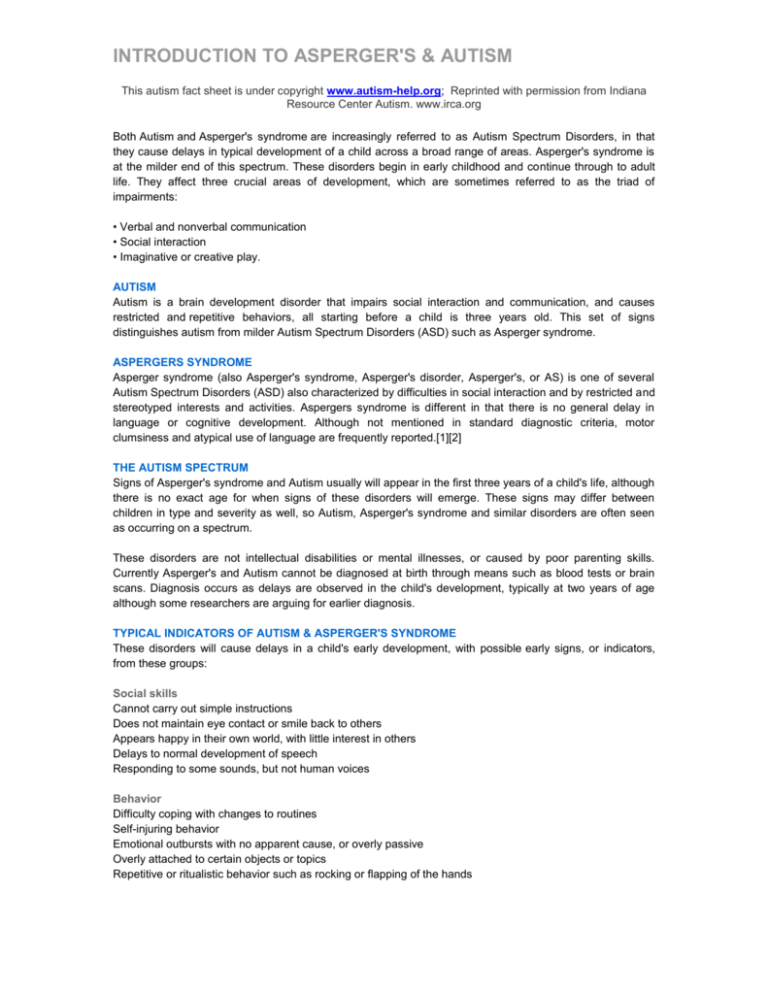
INTRODUCTION TO ASPERGER'S & AUTISM This autism fact sheet is under copyright www.autism-help.org; Reprinted with permission from Indiana Resource Center Autism. www.irca.org Both Autism and Asperger's syndrome are increasingly referred to as Autism Spectrum Disorders, in that they cause delays in typical development of a child across a broad range of areas. Asperger's syndrome is at the milder end of this spectrum. These disorders begin in early childhood and continue through to adult life. They affect three crucial areas of development, which are sometimes referred to as the triad of impairments: • Verbal and nonverbal communication • Social interaction • Imaginative or creative play. AUTISM Autism is a brain development disorder that impairs social interaction and communication, and causes restricted and repetitive behaviors, all starting before a child is three years old. This set of signs distinguishes autism from milder Autism Spectrum Disorders (ASD) such as Asperger syndrome. ASPERGERS SYNDROME Asperger syndrome (also Asperger's syndrome, Asperger's disorder, Asperger's, or AS) is one of several Autism Spectrum Disorders (ASD) also characterized by difficulties in social interaction and by restricted and stereotyped interests and activities. Aspergers syndrome is different in that there is no general delay in language or cognitive development. Although not mentioned in standard diagnostic criteria, motor clumsiness and atypical use of language are frequently reported.[1][2] THE AUTISM SPECTRUM Signs of Asperger's syndrome and Autism usually will appear in the first three years of a child's life, although there is no exact age for when signs of these disorders will emerge. These signs may differ between children in type and severity as well, so Autism, Asperger's syndrome and similar disorders are often seen as occurring on a spectrum. These disorders are not intellectual disabilities or mental illnesses, or caused by poor parenting skills. Currently Asperger's and Autism cannot be diagnosed at birth through means such as blood tests or brain scans. Diagnosis occurs as delays are observed in the child's development, typically at two years of age although some researchers are arguing for earlier diagnosis. TYPICAL INDICATORS OF AUTISM & ASPERGER'S SYNDROME These disorders will cause delays in a child's early development, with possible early signs, or indicators, from these groups: Social skills Cannot carry out simple instructions Does not maintain eye contact or smile back to others Appears happy in their own world, with little interest in others Delays to normal development of speech Responding to some sounds, but not human voices Behavior Difficulty coping with changes to routines Self-injuring behavior Emotional outbursts with no apparent cause, or overly passive Overly attached to certain objects or topics Repetitive or ritualistic behavior such as rocking or flapping of the hands Sensory issues Strong reaction to certain sounds Will not look at objects directly Insensitivity to pain, or extremes of temperature Eating a very restricted range of food types Walking on tip toes Drawn to watching certain patterns or feeling certain textures. Play and imagination Will only play with certain toys, possibly in unusual ways Prefers not to play with others Engages in only a limited range of play Does not engage in pretend play. REFERENCES 1. ^ American Psychiatric Association (2000). "Diagnostic criteria for 299.80 Asperger's Disorder (AD)", Diagnostic and Statistical Manual of Mental Disorders, 4th ed., text revision (DSM-IV-TR). ISBN 0890420254. 2. ^ a b c d e f g Fitzgerald M, Corvin A (2001). "Diagnosis and differential diagnosis of Asperger syndrome". Adv Psychiatric Treat 7 (4): 310–8.


